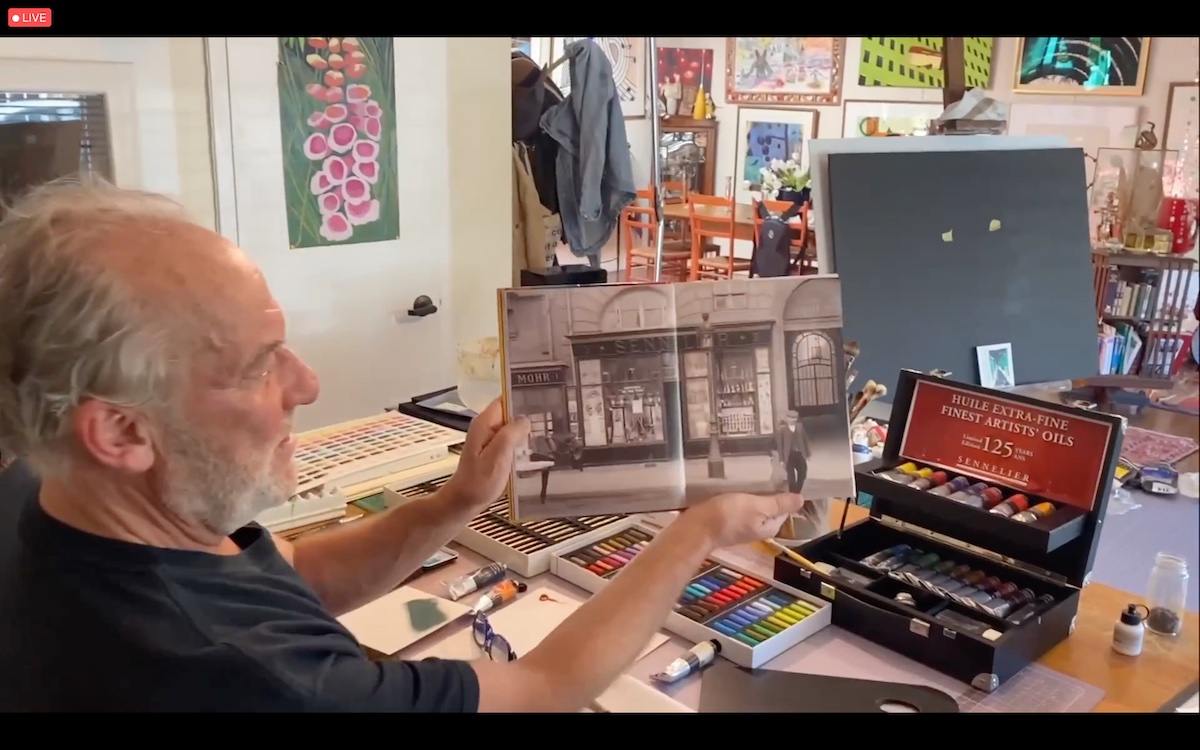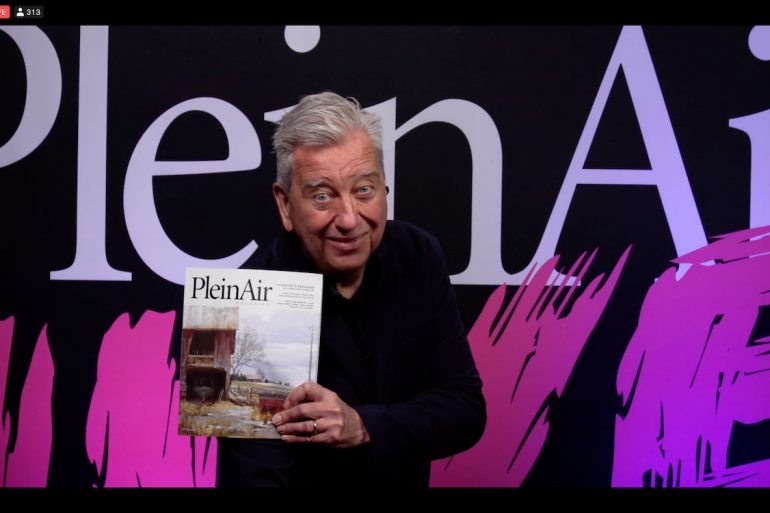
This post is also available in:


We at Miami Niche told you at the last event, Watercolor Live:” don’t be nostalgic and if you are you just have to sign up for Plein Air Live.” And here we are savoring the energy and enthusiasm of Eric Rhoads and Kelly Kane, together again for this plein air adventure.
After all, those who know him know: Eric Rhoads, is a tireless mind and the inexhaustible source of ideas, which aims to create a Disneyland for artists.
Now in its third edition, Plein Air Live brings together more than thirty artists and thousands of participants from twenty-two countries around the world for this incredible four-day event dedicated entirely to painting en plain air, with a wide range of mediums and subjects to represent.
As with the other events, the convention starts with the beginner’s day: a valuable informational and practical resource for those who want to approach plein air or want to learn more.
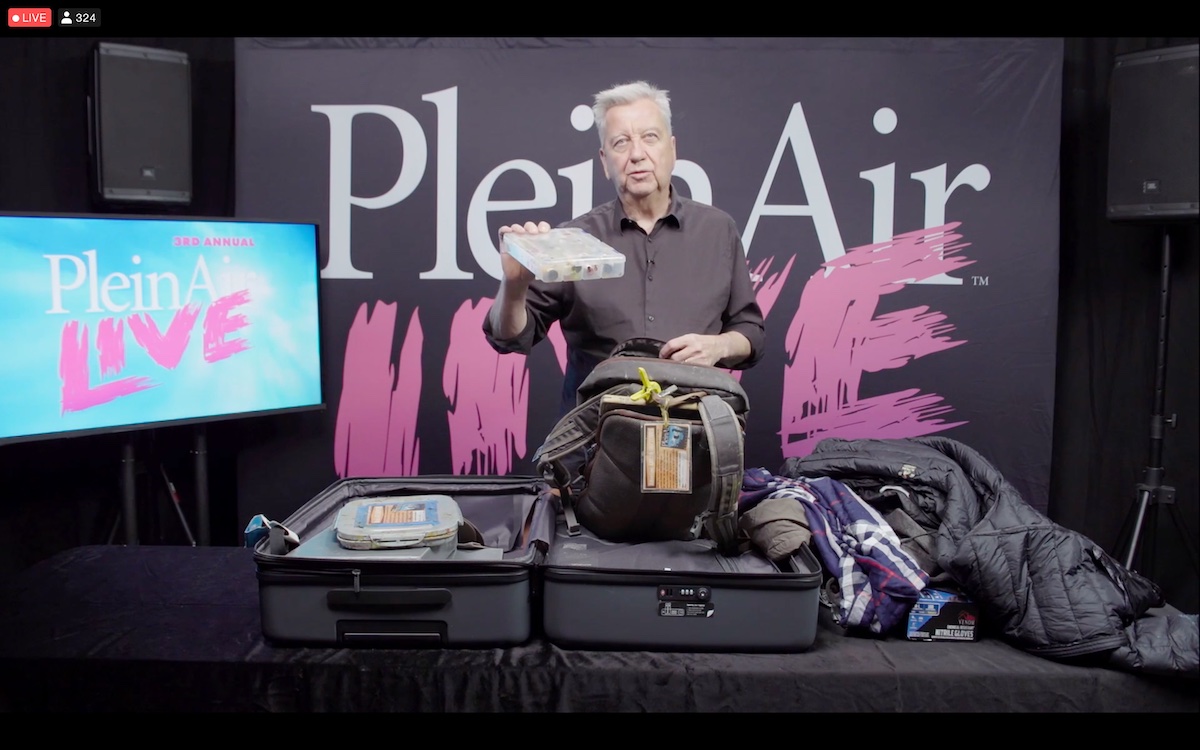
After the greetings from the beaming Eric Rhoads and Kelly Kane, the event got into the swing of things.
There were multiple guest lecturers who addressed disparate topics. Eric Rhoads himself, a successful entrepreneur and artist, gave a lecture on the tools needed and their organization to make a plein air session. In addition to being an entrepreneur Rhoads is also a well-regarded artist who is passionate about plein air. “Growth from the mistakes” says E.Rhoads while presenting the necessary material, and its organization, for this kind of painting inspired by the French impressionists who were looking for “impressions” to leave on the canvas. Rhoads, strong with his years of experience, has left nothing to chance both in the organization of his backpack, in which he places the essential elements, and in the organization of the suitcase that he carries on his journey and that must be rigorously ready for every eventuality: from rain to sun; from wind to snow. The important thing argues Rhoads is however always to have a light and easy luggage. and above all remember to put on display the stickers Plein Air Live provides to participants.
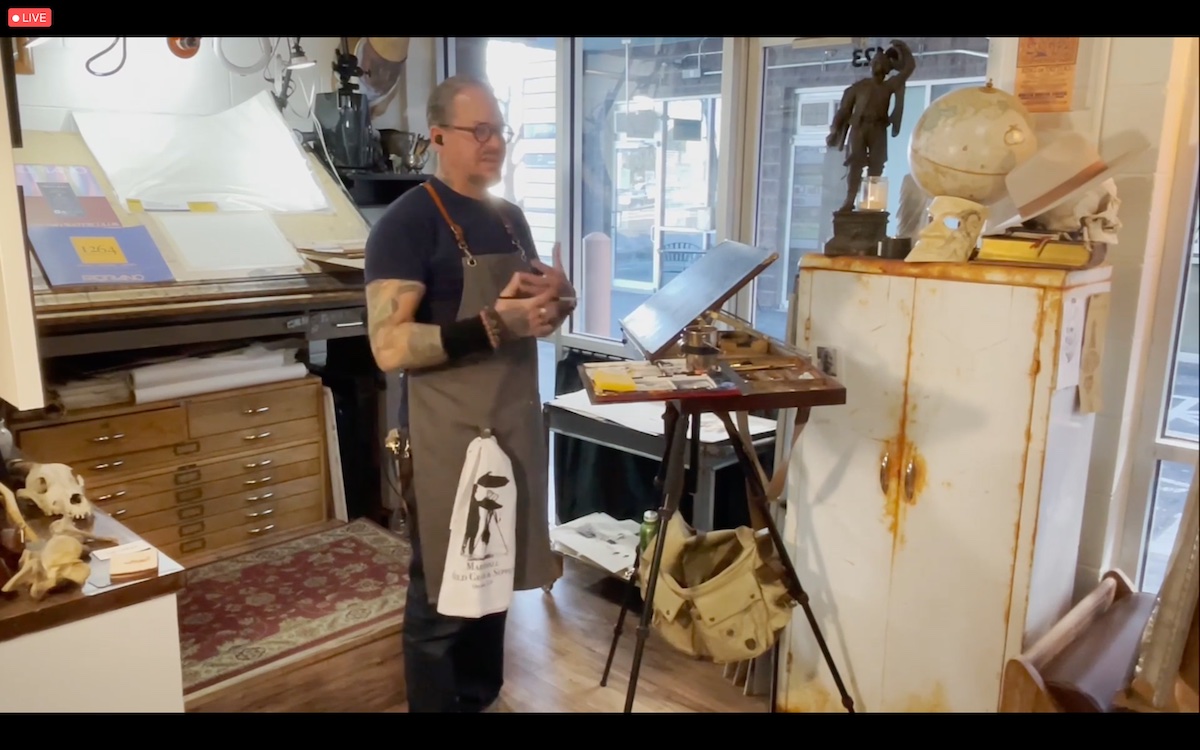
Dan Marshall in his demo did not make a session on the good output or not of watercolor but rather on the importance of knowing perfectly the tools that allow you to perform a good session in plein air. In this regard, the artist has shown, from the confines of his studio in which it is impossible not to notice a beautiful workbench, how to perform simple exercises with the brush. These are exercises that require 5/10 minutes a day and that guarantee to improve the knowledge of the materials. A fundamental component to be able to go out and paint in plein air and be familiar with the environment. From his splendid studio, perfectly organized, Marshall made small exercises of calligraphy applied with a brush so that he could later go into the realization of a more complex work. In choosing the objects to represent during the daily exercises, the artist advocates the importance of choosing three-dimensional and particular objects. These objects will avoid that our brain perceives them in a mechanical way and therefore full of errors and prejudices.
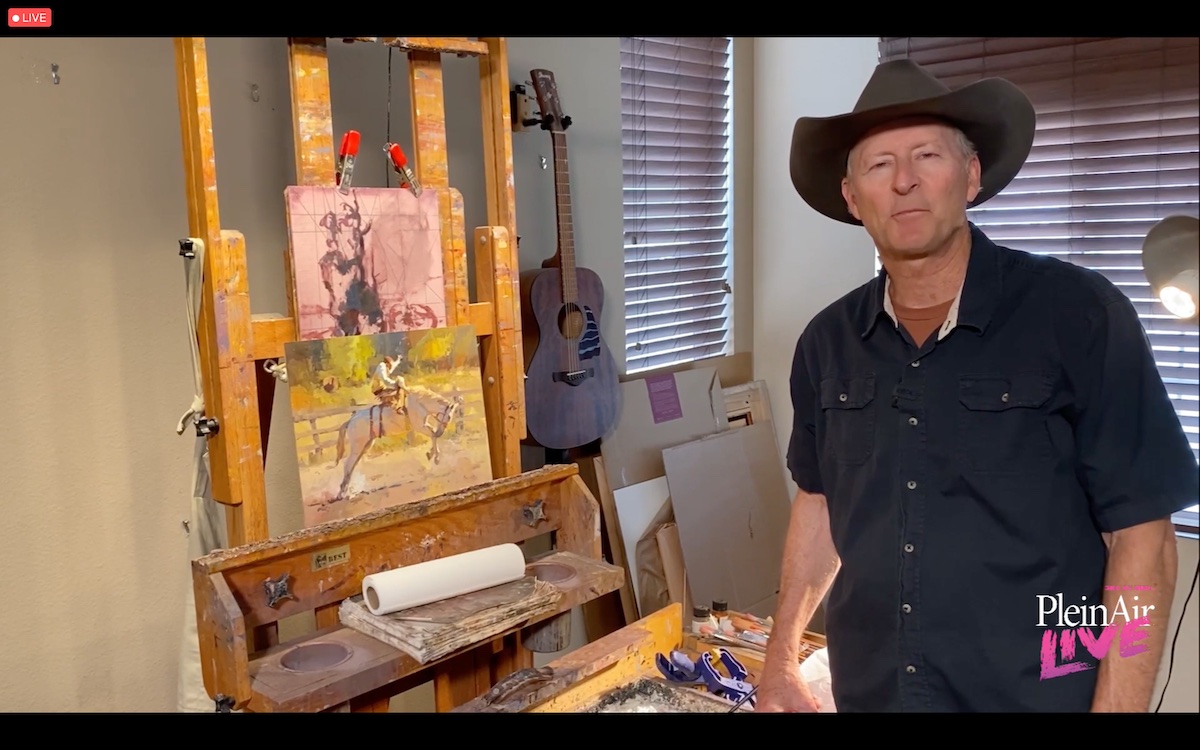
According to Jim Wodark the composition of the work is fundamental to the success of an artistic work. The artist in his compositional process starts from simple but equally effective questions: “why am I painting? what do I want to represent?” This allows him to focus on what will be the points to highlight in the realization of the work. Wodarck treats the subject of composition in a number of possible ways. He starts from the most common methods such as the representation of large shapes, triangles and circles, to the theory of the anatomy of the rectangle and the Fibonacci sequence as a harmonic rule for everything. The Fibonacci sequence in particular, derives from the name of its inventor, Leonardo Pisano who coined this system of measurement in 1202. It is basically based on the ratio of 1/16 that governs nature and the golden session, and is the rule of many pictorial and architectural works. All of these methods approached in the demo allow the artist to focus each object in the composition correctly and with respect to the measurements, proportions and negative spaces in relation to the focal point.In the realization of the composition it is also important to consider the compositional tools, i.e. the set composed of: lines (thin – marked), shapes (small – large), values (light – dark), colors (gray – color), edges (hard – soft) and the impasto (thin – thick). Composition is the result of the balance of all these factors put together correctly.
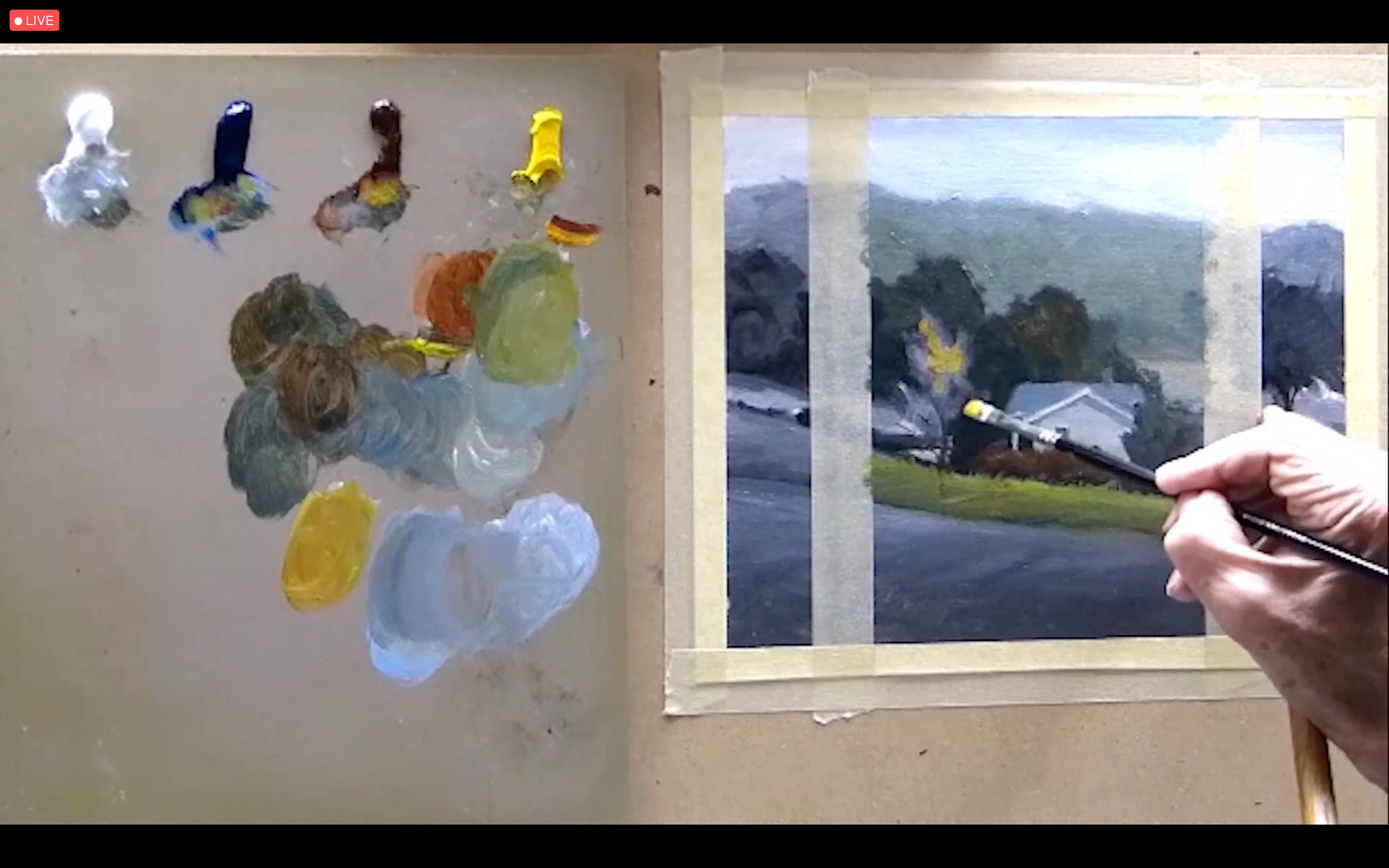
“I’ve also been a beginner and the most important thing you have to do is learn the concepts and put them into practice,” says English-born artist John Pototschnik in his demonstration on color. Pototschnik maintains that in the creation of a work of art, it is the values that create the mood of the composition. For this reason, it is essential to take into account certain fixed points: appreciating the value of the values; understanding the aerial perspective, benefact from a limited palette and discerning a color value. Arguments of which Pototschnik makes ample demonstration in his book and dvd: John Pototschnik: Unlimited Color with a Limited Palette, which contains all the fundamental points that the artist has put into practice during his demo putting particular emphasis on the benefits of the limited palette in the ease of understanding color and its harmony. The book and the dvd are available at the following link: https://painttube.tv/products/limited-palette-unlimited-color-book
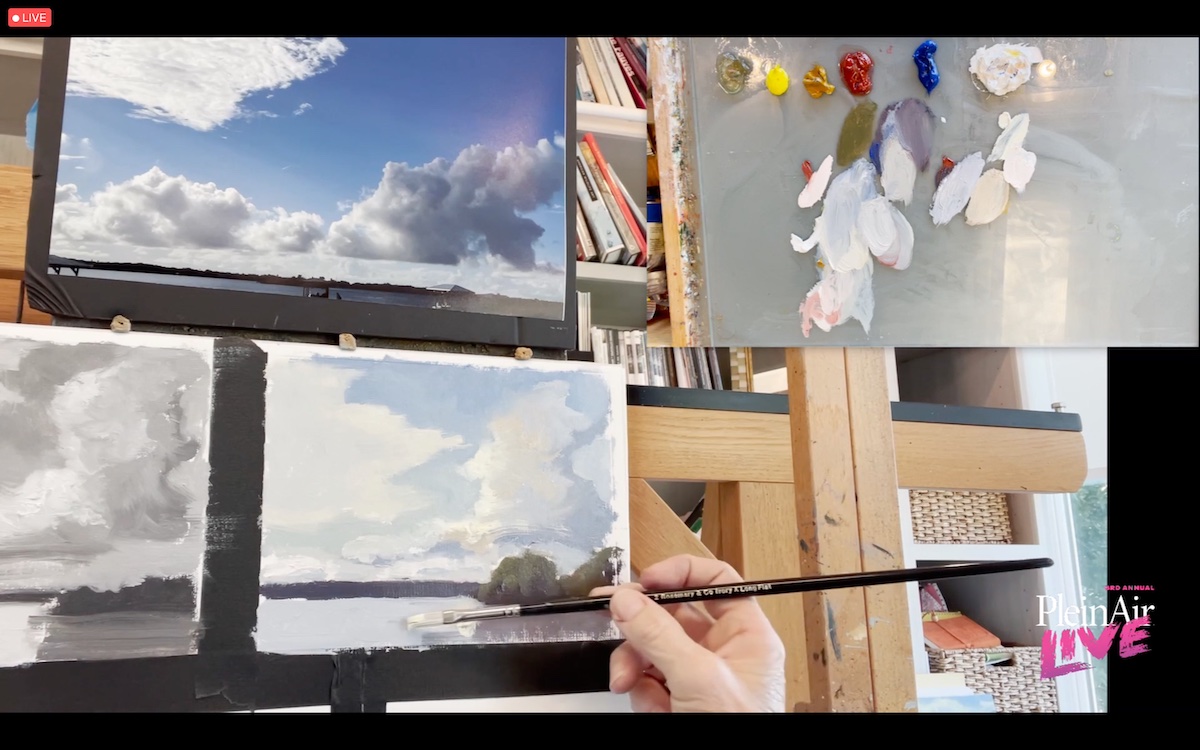
The afternoon continued with plein air demonstrations in different mediums.
The first artist of the afternoon was Mary Garrish who delighted the audience with an oil landscape representing a sky full of clouds. In the realization of the work, the artist showed the various stages of work that anticipate the final realization of the painting: starting from the change of the image from colored to black and white, thus highlighting the shades of gray, to the realization of sketches that she has modified at will for her personal interpretation. Before arriving at the final work, she made a value study in oil in black and white in order to highlight the tonal values, useful in translating the color. Garrish, who gave up her practice as a doctor to devote herself entirely to painting, says her preference is tonal paintings, which she tends to paint with a more neutral palette and then goes so far as to add more color in the desired focal area.
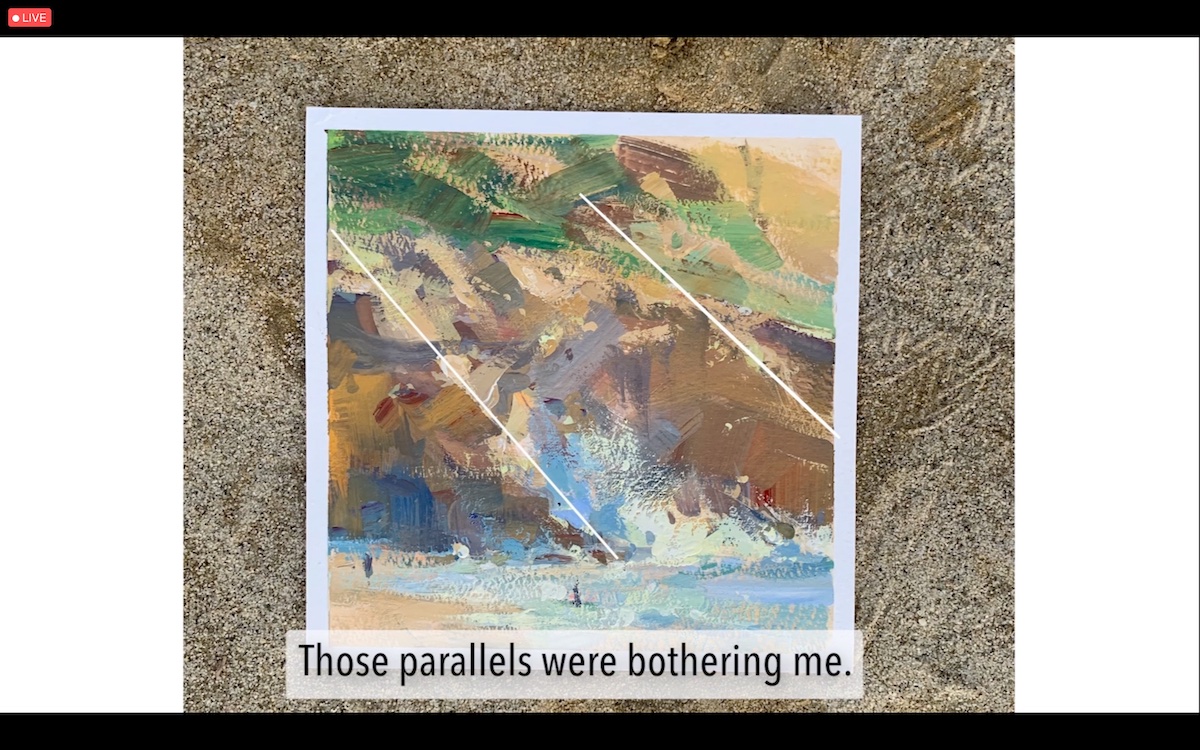
Tiffany Mang created a plein air session in Cutiver Park, La Jolla, CA, using gouache. Mang has been making plein air landscapes with gouache for several years because she considers it a very versatile material. The artist habitually uses cold pressed paper on small dimensions (6 x 6″) and prefers fabric cloth to paper cloth.
A minimalist artist, Mang uses only two brushes: a flat one and a round one to refine the shapes. Beyond that she uses only the three primary colors, preferring to sketch the composition directly on the paper with a pencil and an extender. Seeing Mang at work harks back to abstract painting in some ways with a verve of cubism because of the brushstrokes. The final effect of her composition is a pleasant fragmented succession of brush strokes. For Mang, in addition to technical skill, it is important to have a good problem solving ability, a means that helps to overcome any problems due to, for example, an iridescent shape as the sun goes down. In order to adjust the painting, Mang suggests taking a photograph of the work and analyzing its lines and composition.
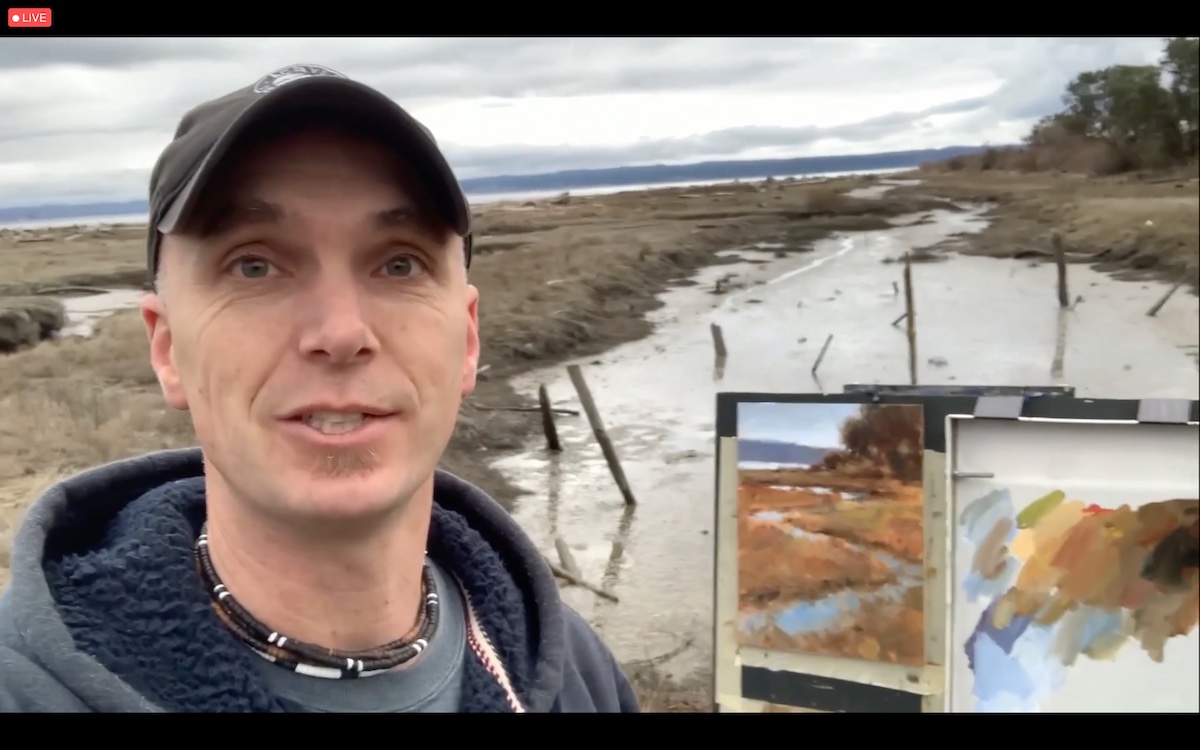
Jed Dorsey, declares himself a “huge proponent” of acrylic painting and to get to the desired spot where he made the plein air session he took a long walk. As he begins his work Dorsey sketches out the large shapes on the board with the help of a medium-large marker. It’s fun to listen to him tell some anecdotes about the old masters and their way of stepping away from the palette to refresh his gaze. The artist argues that in plein air painting it is not necessary to copy the subtleties, but rather it is necessary to know how to interpret it, because: “You can’t improve nature but you can improve your painting”, says the artist borrowing a famous quote. Dorsey for the demo used a limited palette with the addition of brown and for each color obtained from the combination of colors he makes a test on a sheet of gray paper placed parallel to the composition. This process offers a chance to correct the color before laying it out. To finish, the artist made a very poetic quote, “painting comes and goes, but you are the real work of art”.
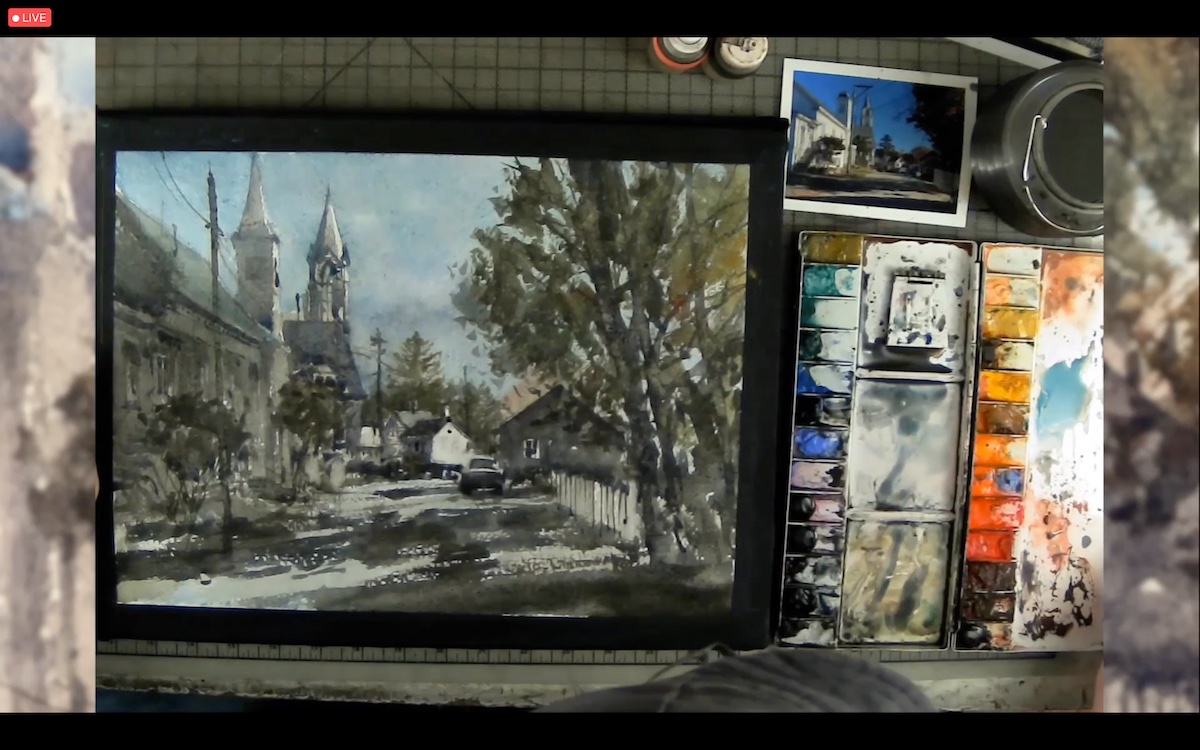
A degree in architecture and a master’s degree in design have not deterred Thomas Bucci’s passionate love of watercolor. For the realization of the demo, he helped himself with a tiny photograph of an excerpt of a city that he reworked in the sketch, highlighting its tonal values. His technique consists of laying down large washes that he later refines with tonal values and details. According to Bucci, in the realization of a watercolor work, it is necessary to keep in mind two fundamental principles: to have skill in drawing because it is not possible to go backwards in the realization of the work, and not to overload the sheet with water and pigments, thus risking ruining the paper and the composition.
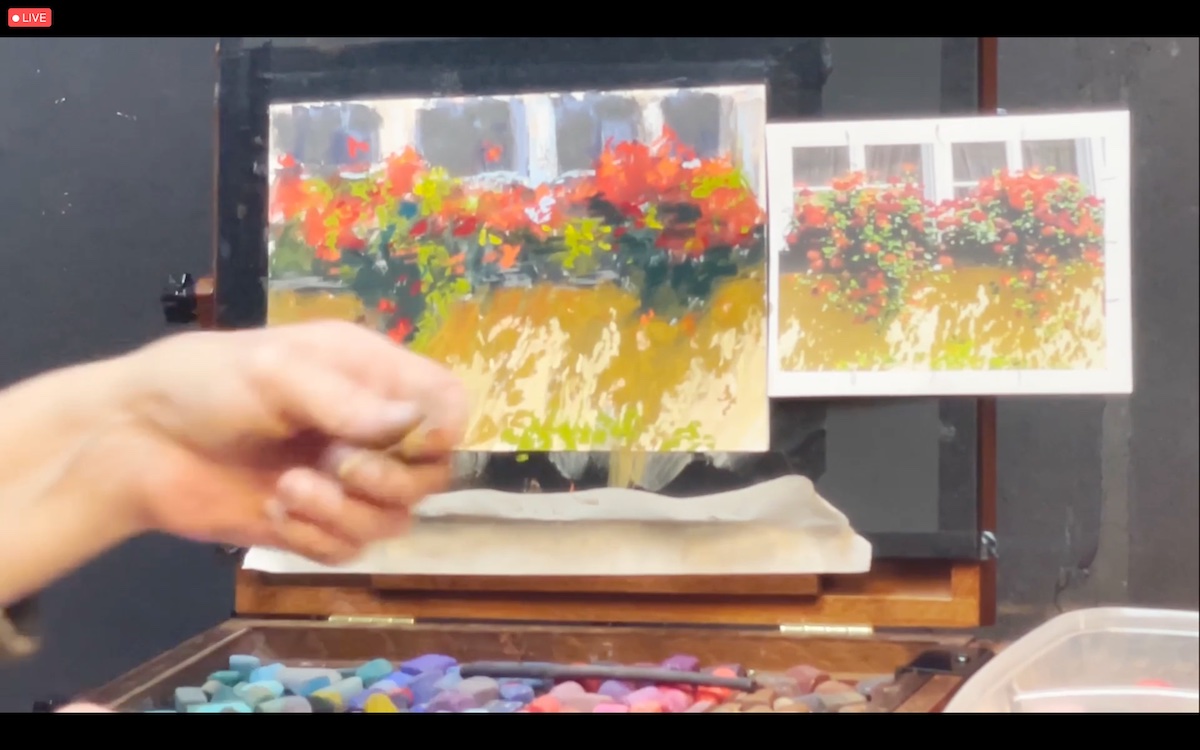
Susan Kuznitsky, is a familiar face in the pastel milieu and has painted an extraordinary flowered balcony for the occasion. Pastel is a medium that she knows perfectly and that she particularly appreciates for its ability to be applied in layers. In addition to being a great artist, she is also a great teacher, and with regard to the material needed for the plein air session she says: “what you don’t remember the first time, you won’t forget the second time.”
In the practical realization of the work she usually arranges a long strip of thick adhesive tape along the lower edge of the sheet, in order to avoid the dispersion of the dust of the pastel, which can be very annoying to remove. In the composition he proceeds by tracing reference strokes that subdivide the composition into zones and then trace the large shapes. Before passing to the definition of patterns and details that create three-dimensionality, she amalgamates the composition with alcohol, applied with a brush.For those who want to approach this practical and fast medium Kuznitsky suggests to start with hard pastel which, containing less pigment, is easier to handle.
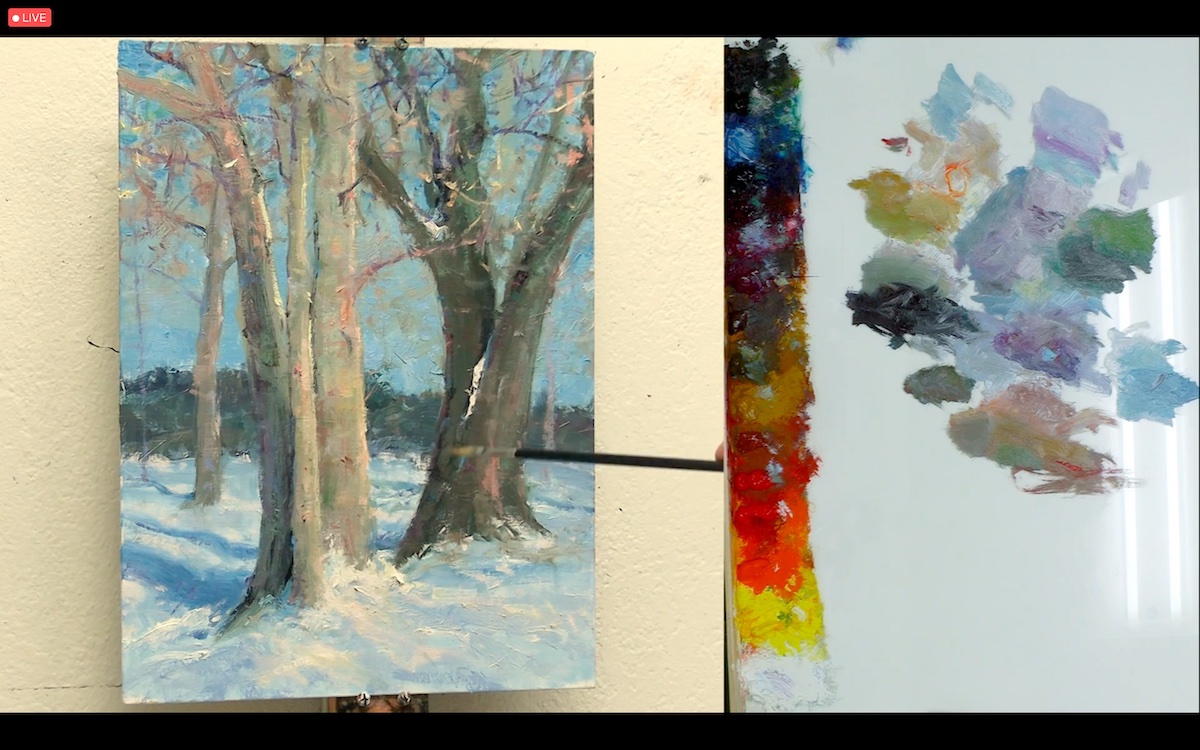
Bill Inman concluded the educational day with an oil demonstration of a snowy landscape. After forty years of plein air painting Inman created a demo that began outdoors and ended with a photographic reference in the studio. A demonstration that allowed participants to understand how to deal with representation from photographic reference in a way that made the image as natural as possible. “Each of us is unique and has its own perception of nature, which is why each person must understand what they want to emphasize and what not,” says the artist. A sublime and equally simple plein air painting lesson that reviewed several difficult to put into practice topics such as the perception of light and color. According to Inman, all that matters is memorizing the elements of nature and being receptive because in the plein air, light changes dramatically in a matter of minutes. In addition, the artist stresses the importance of squinting in order to focus on the tonal values and details that make a composition unique and sublime.
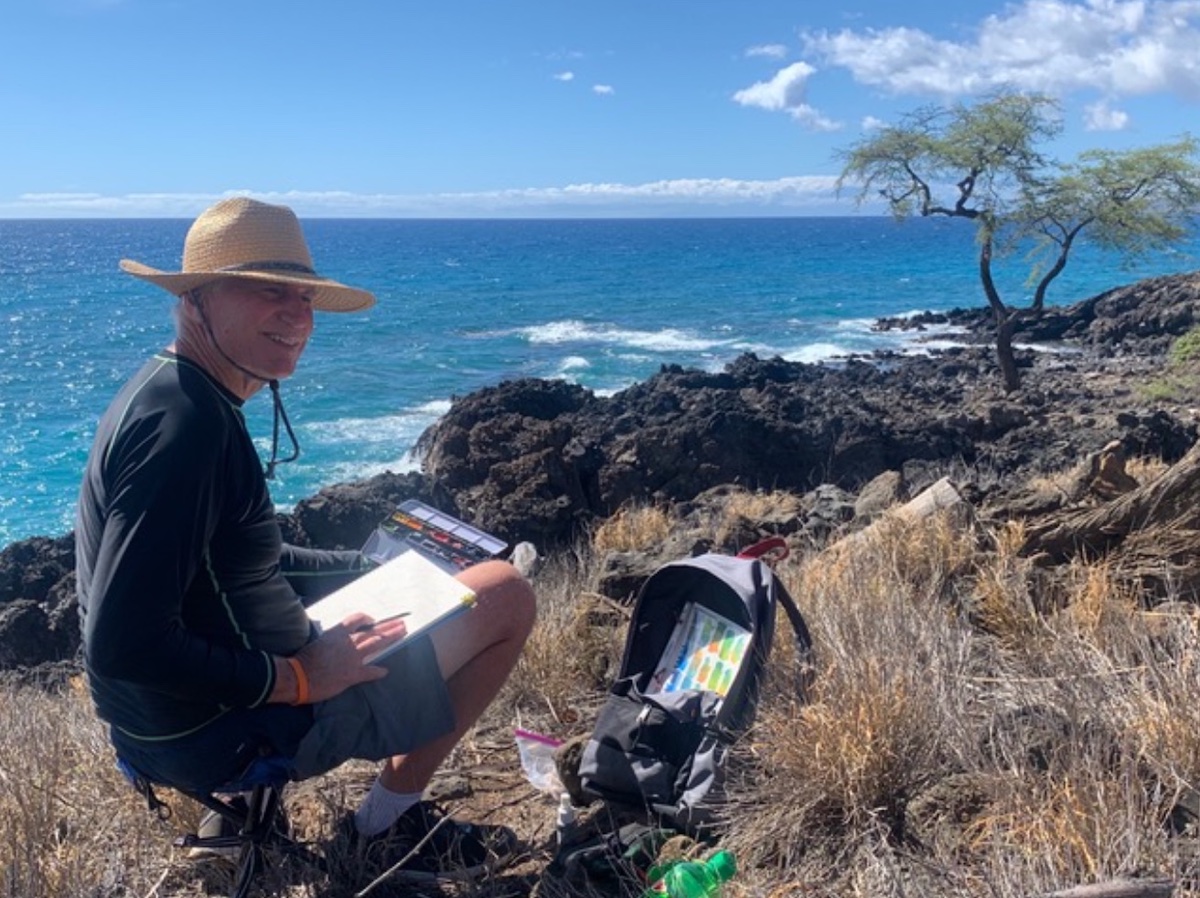
It’s always interesting to hear the demonstration sessions from the various sponsors who deliver real lectures, which are in effect rich and valuable vehicles of information for attendees of Streamline Publishing events. Among the event’s platinum sponsors is LPAPA- Laguna Plein Air Painters Association- a non-profit organization aimed at promoting the tradition of plein air painting and preserving the artistic heritage of Laguna, CA. You don’t have to be a California resident to join, just sign up at the link: https://lpapa-portal.org/join
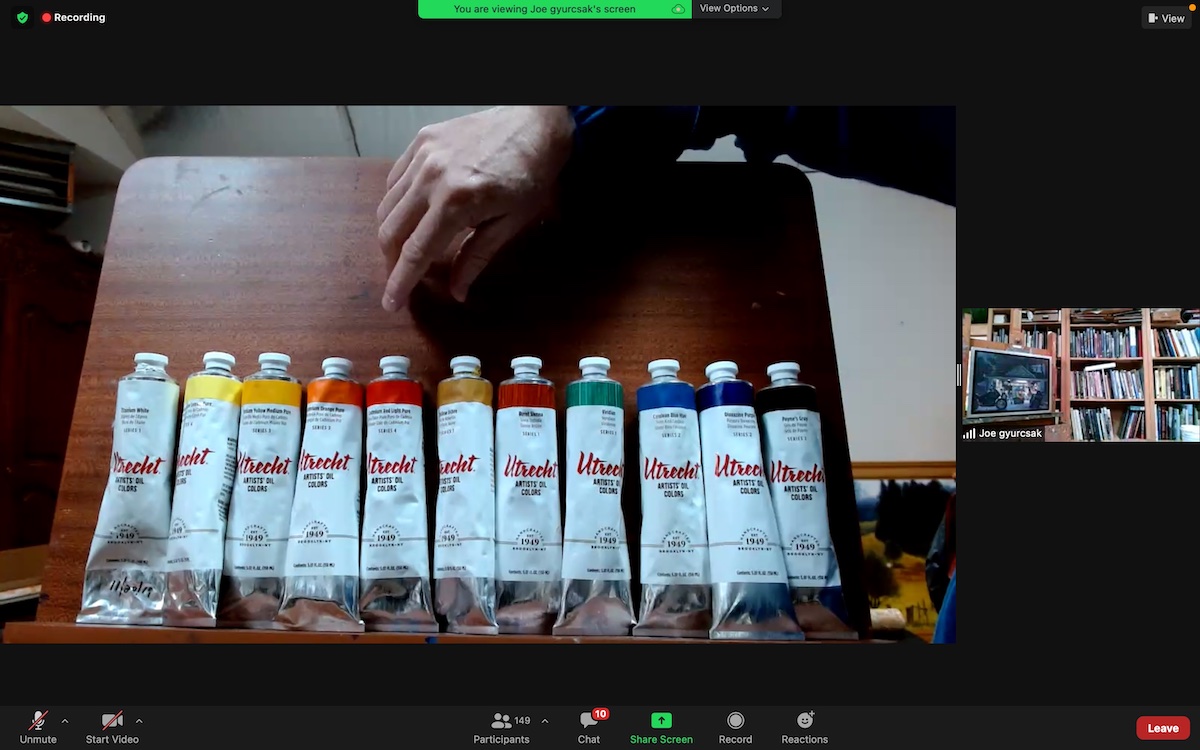
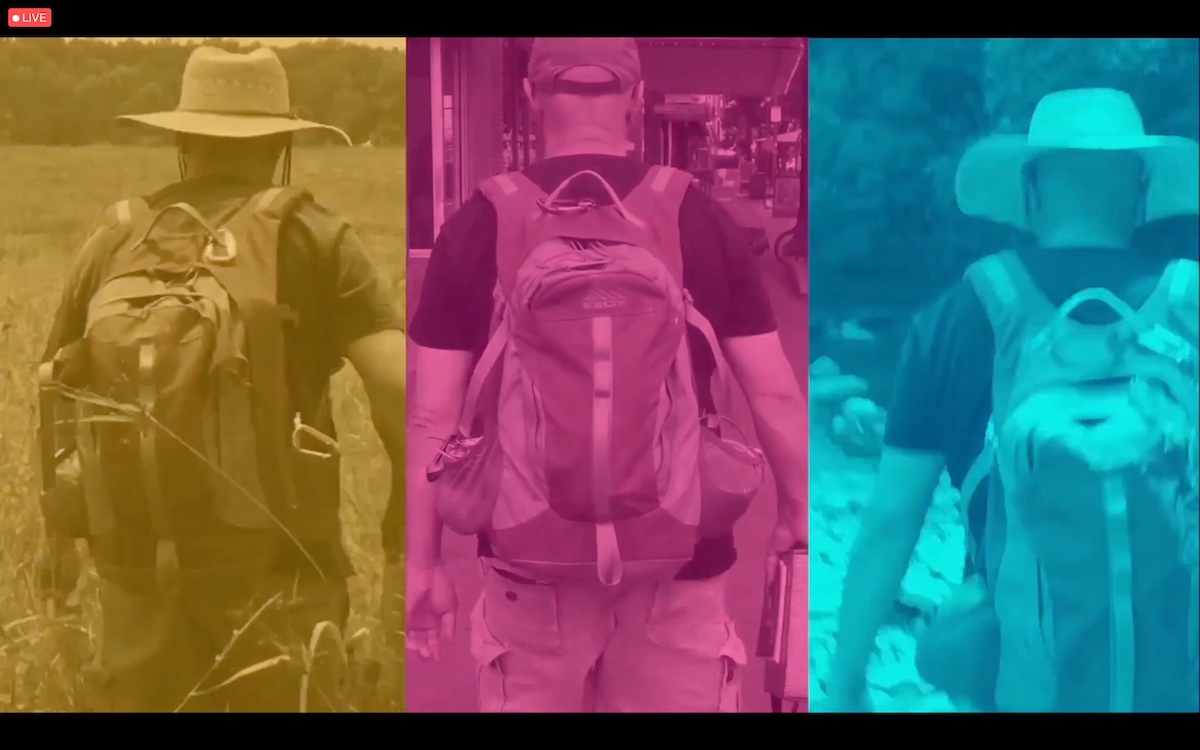
Blick Art Materials is another platinum member of the event and for the occasion has availed itself of the expertise of two artists: Joe Gyurcsak, ambassador member and manager of Utrecht who advised -for those who are beginners- to use Utrecht oils, available in convenient large format tubes that help to avoid waste; and Troy Kilgore who showed the necessary equipment, comfortable and light, that he usually uses in his plein air sessions.
All the equipment is available at https://www.dickblick.com
The day has come to a close and Miami Niche looks forward to seeing you on time for the official start of the convention. Readers are also reminded that it’s official: PACE -Plein Air Conference and Expo- will return, this year in person and will do so May 17-21, 2022, in Santa Fe, New Mexico.
(on the title, Eric Rhoads founder of Plein Air Live event)
